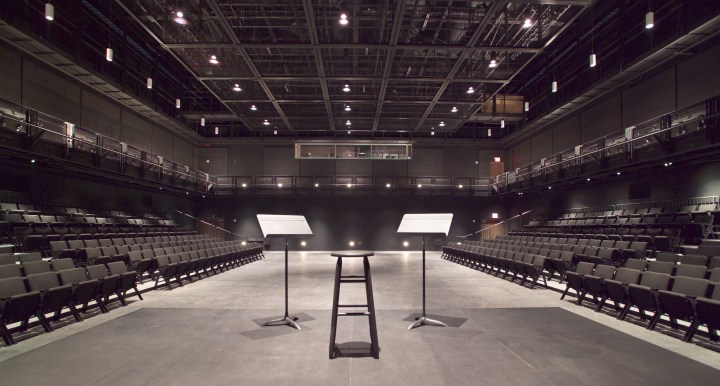
Regional theaters struggle to recover from COVID closures
Share Now on:
Regional theaters struggle to recover from COVID closures

When the pandemic shuttered retailers, schools, restaurants and cultural institutions around the world, theaters were no exception. But while many other businesses reopened or found ways to continue to make money through 2020, theaters were physically closed for months to over a year.
Those closures caused staggering economic impact to the arts sector. SMU Data Arts estimates that through December 2021, the nonprofit performing arts industry lost more than $3.2 billion as a result of the pandemic. In August 2020, Brookings estimated that fine and performing arts industries had lost almost 1.4 million jobs since the pandemic began — half of the total jobs in those industries.
Regional theaters have particularly struggled to recover from those losses and get customers back in seats. Average ticket sales for performing arts organizations are at 75% of what they were pre-pandemic, and may reach 80% by year’s end, said Zannie Voss, director of SMU DataArts. The story of how audiences have and have not returned and where organizations are feeling that strain is different place to place, but across the board, almost nowhere is back to 2019 numbers.
At La Jolla Playhouse in San Diego, California, subscribers have mostly kept their season tickets, but there’s been a big drop in single ticket sales. At Alliance Theatre in Atlanta, Georgia, it’s the opposite — subscriptions are down 40% compared to before the pandemic.
Raising ticket prices to compensate for lower sales and inflation-driven higher production costs might feel like the obvious solution, but that could drive even more patrons away.

“You don’t want to over-price in an inflationary period where people’s perceptions about economic uncertainty are really pronounced,” said Voss. “And at the same time, the organization’s recognize that they need to bring in money in order to stay afloat.”
In fact, there’s been an increase in sliding scale ticket models or pay what you can options, said Jill Robinson, CEO of TRG Arts, which does consulting for arts organizations and collects data on their sales. Some organizations have increased prices modestly and others have decreased — whatever it takes to get audiences in seats while keeping the lights on.
In places where attendance is close to normal, Robinson said, revenue is still down because patrons are paying cheaper prices for not-as-good seats rather than splurging during a time of economic uncertainty.
Theaters have also not escaped the inflationary pressures and supply chain issues that have plagued other businesses.
“Sheets of plywood, sticks of steel, bolts of fabric, and then even the cost of paper to send the postcard out about the production costs more than it used to,” said Mike Schleifer, the managing director of Alliance Theater.
Production costs have always fluctuated, but inflation and supply chain backups certainly haven’t helped theaters bounce back from pandemic closures.

At Barter Theatre in Abingdon, a town of just over 8,000 in southwestern Virginia, the set designers and builders have carefully reused old set pieces and existing materials since the onset of the pandemic. But as they plan the 2023 budget, producing artistic director Katy Brown anticipates a 20% increase for lumber, building materials, and paint costs, compared to 2019.
She said concessions are costing the theater more too, though they’ve purchased less since masking means fewer patrons buy snacks and drinks.
And as the world opens back up, travel for touring productions and housing or car rentals for out of town cast members are all costing more than they used to, said Elisa Spencer-Kaplan, managing director of Theater Latté Da in Minneapolis, Minnesota.
The pandemic also brought with it new health and safety protocols. Routine testing is the norm now in many theater companies, which isn’t cheap. Some organizations purchased HEPA air filters for theaters and rehearsal spaces, as well as see-through masks used in the earlier part of the pandemic during performances.
Hiring understudies — which may have previously been out of budget for smaller companies — is now in many cases necessary. As is the hiring of a COVID safety officer to oversee ever-changing pandemic protocols.
The theater industry also felt the punch of the Great Resignation, especially as work was nearly nonexistent during lockdown.
“Those that stayed and those that are entering the field, I think still have the deep passion for the work but simply won’t accept the poverty that often came with a career in the arts, and nor should they,” Schleifer said.
In response, Alliance Theatre brought up minimum pay, gave raises and bonuses, conducted pay equity studies and improved benefits, he said. But it all adds up — at Alliance Theatre, labor makes up about 70% of costs.
“If we’re going to overcome what is really just an existential crisis in the American theater, we’re surely going to need some additional support from the government,” said Schleifer. While PPP loans, employee retention tax credits and the Shuttered Venue Operators Grant kept many theater staff employed during the pandemic, those programs are over. And smaller theaters have less capacity to fund raise, write grants or apply to federal programs, leaving the future of regional theater uncertain.
That also leaves all the small businesses that thrive around a theater, from bed and breakfasts to restaurants, wondering about their futures.
There’s a lot happening in the world. Through it all, Marketplace is here for you.
You rely on Marketplace to break down the world’s events and tell you how it affects you in a fact-based, approachable way. We rely on your financial support to keep making that possible.
Your donation today powers the independent journalism that you rely on. For just $5/month, you can help sustain Marketplace so we can keep reporting on the things that matter to you.


















